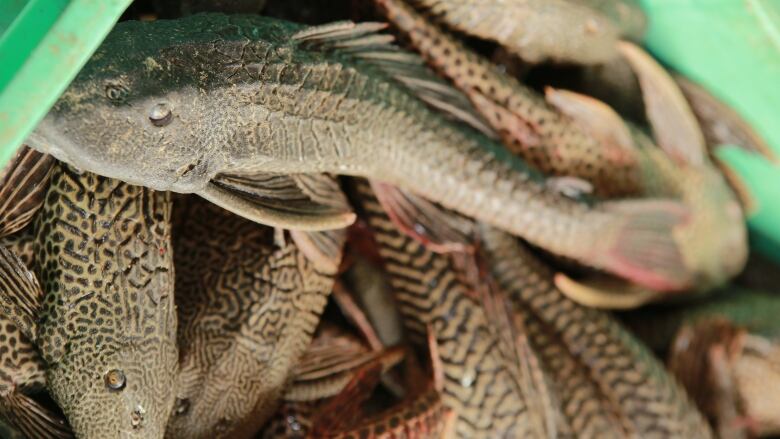Entrepreneurs hope to sell Mexico's 'devil fish' to Canadians as a sustainable snack
Seeing a scourge as a memorable morsel requires looking beyond an ugly skin

Fish jerky is an acquired taste. Think of itas a piece of leather that's been left to soak in a bait bucket.
"We're going to refine the recipe a little bit more," saysMike Mitchell, theman behind El Diablito fish jerky.
Mitchell, 30, is hoping to turn devil fish, an environmentalplaguein Mexico, into a tasty snack for Canadians. The American'sbusiness may depend on whether he can create enough appetite in Canada for the snackorperhaps more importantly, for the story behind it.
He andSamBordia, 29, a fellow University of California Berkeley student, had hoped to get their first bags of jerky into U.S. stores by mid-August. Buta U.S. law,aimed at protecting American catfish farmers from cheaper Asian imports, means there is effectively a ban on foreign catfish including thesuckermouthor devil fish, from entering the U.S.

"We were always looking at kind of going into Canada and pursuing the sustainability-minded customers in Canada as well,"Bordiasaid. "Now this just ramps up those efforts quicker.
"Just this last week we started looking into what we need to do to comply with Canadian regulations, and then we can start shipping it around Canada, which is a really exciting opportunity for us."
Bordiawants potential customers to know,"The flavour is not anything like catfish.The texture is nothing like catfish."
The chewy brown strips begin life in the rivers of Mexico as the hard-shelled bottom-feeder Hypostomus plecostomus, or suckermouth catfish. But Mexican fishermen have given the lizard-like fish another name: pez diablo. Devil fish.
Mitchell came across the fish in 2014 while on a Fulbright scholarship in Mexico to study the socio-economic impact of small-scale fish farming.
"And this issue kept coming up: the pez diablo, the devil fish. I started asking around at the university that I was working at, and realized that it was just the common sucker fish or cleaner fish."
Aquarium owners may know themas a type of pleco fish that are often bought to keep aquariums clean because they eatalgae. They'revery good at it.

Native to the Amazon River, the acari, as it's known in Brazil, has spread so successfully in Mexico, it now accounts for more than 70 per cent of the wild fish captured in the regions it has invaded.
"It's highly aggressive and it reproduces like crazy," Mitchell said. "So it's really like a evolutionary miracle."
This miracleisn't much to look at: it's all spines and scales, and it turns a cadaverous grey when cooked. Many people wrongly believe it's poisonous. Because few outsideBrazil are willing to eat it, it's usually considered a trash fish.
"I started poking around a little bit more and found out that it was indeed edible," said Mitchell. "A lot of the properties that make it a hard fish to cookas you would,say, a normal white-fleshed fish, actually lends itself very well to making jerky."
Last November theybuilt a small processing plant in Mexico. Instead of throwing out the pez diablo they caught by accident, local fishermenwere soon catching the fish on purpose and selling them to Mitchell and Bordia's newly formed company:Acari Fish.

According to Bordia, the key to the company's long-term futurewill be convincing North Americans to eat a fish most have never heard of before.
"By eating our fish, it's not only that you're not harming the environment, you're helping the environment," Bordia said. "So we seea really positive story that we can tell."
In addition to selling fillets and jerky, Mitchell said, the company will eventually offer fish balls and burgers. He saidAcari Fish has cultivated and processed approximately 9,100 kilogramsof devil fish since 2016. Whether they can scale up enough to make the business self-sustaining is still a question.
Kim Thompson, who manages theSeafood for the Future program at the Aquarium of the Pacific in Long Beach, Calif.,says many other sustainability-minded companies have tried to sell Americans on eating invasive specieslike the lionfish, with mixed success.
But there's little hope of eliminating an invasive species just by gobbling it up,Thompson said.
"The problem with some species like lionfish, or species like the devil fish is that they're pretty prolific," Thomson said. "So realistically you're not going to eradicate them, but you can keep them under control."

Research suggests this is possible, Thompson said, with good fishery management and even better marketing.
"Nobody wants to eat trash fish.But the general concept of eating these underutilized species is a good one, and we need to be more open to trying new things if we want to support a healthy food system."
Mitchell and Bordia are working with lawyers and lobbyists to get an exemption that would allow them to import their devil fish to the U.S. Meanwhile, Bordia works part-time as a teaching assistant at Berkeleyto "pay the rent."
"Right now, we're surviving off of grant money," he said.
Days after graduating with master'sdegrees in development practice, Mitchell and Bordia strolled towarda bank near the Berkeley campus, carrying some paperwork and a small envelope.













_(720p).jpg)


 OFFICIAL HD MUSIC VIDEO.jpg)
.jpg)



























































































